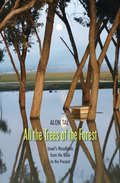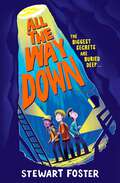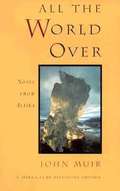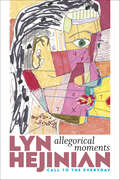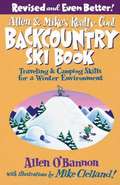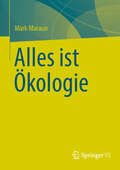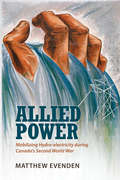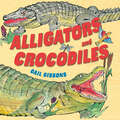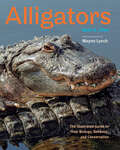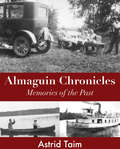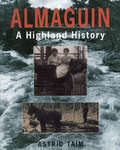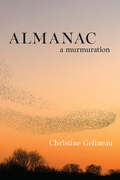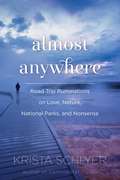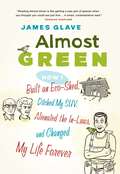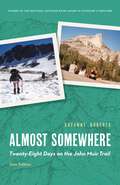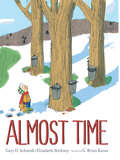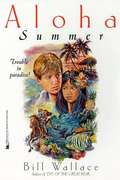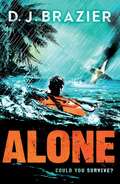- Table View
- List View
All the Trees of the Forest
by Alon TalIn this insightful and provocative book, Alon Tal provides a detailed account of Israeli forests, tracing their history from the Bible to the present, and outlines the effort to transform drylands and degraded soils into prosperous parks, rangelands, and ecosystems. Tal’s description of Israel’s trials and errors, and his exploration of both the environmental history and the current policy dilemmas surrounding that country's forests, will provide valuable lessons in the years to come for other parts of the world seeking to reestablish timberlands.
All the Way Down
by Stewart FosterA life-affirming story about friendship, adventure and self-belief, from the award-winning author of The Bubble Boy. Perfect for fans of Louis Sachar&’s Holes and Elle McNicoll&’s A Kind of Spark. When three eleven-year-old &‘problem children&’ are thrown together at summer camp, they&’re challenged to build a place to live together for the next week. But after a trip to a disused tin-mine goes awry, Milo and his new friends, Oscar and Effie, soon find themselves split off from the group and trapped underground. Can they work through their individual issues and come together as a team to find their way to freedom?
All the World Over: Notes From Alaska
by John MuirMuir explores into the vast and varied splendors of the natural world in Alaska.
Allegorical Moments: Call to the Everyday
by Lyn HejinianAllegorical Moments is a set of essays dedicated to rethinking allegory and arguing for its significance as a creative and critical response to sociopolitical, environmental, and existential turmoil affecting the contemporary world. Traditionally, allegorical interpretation was intended to express an orthodoxy and support an ideology. Hejinian attempts to liberate allegory from its dogmatic usages. Presenting modern and contemporary materials ranging from the novel to poetry to painting and cinema to activist poetry of the Occupy movement, each essay in the book "begins again" with different materials and from different perspectives. Hejinian's generative scholarship looks back to experimental modernism and forward into a future for a vital, wayward poetry resistant to the crushing global effects of neoliberalism.
Allen and Mike's Really Cool Backcountry Ski Book: Traveling and Camping Skills for a Winter Environment
by Allen O'Bannon Mike ClellandAllen & Mike are back with totally updated information and first-hand advice for all aspects of backcountry skiing and winter camping. Learn how to choose the right equipment, avoid hazards such as avalanches and extreme cold, build snow shelters, and have fun while staying safe and minimizing the impact on the wilderness. These two National Outdoor Leadership School instructors offer lots of tried-and-true tricks and useful tips drawn from years of experience.
Alles ist Ökologie
by Mark MaraunDie Idee des Buches ist es zu zeigen, dass Ökologie keine Teildisziplin innerhalb der Naturwissenschaften ist, sondern große Bedeutung für alle Bereiche unseres Lebens hat. Überall wo Organismen interagieren (und das ist ja quasi überall der Fall) gelten die Prinzipien der Ökologie - nur welche sind das überhaupt?
Allied Power
by Matthew EvendenCanada emerged from the Second World War as a hydro-electric superpower. Only the United States generated more hydro power than Canada and only Norway generated more per capita. Allied Power is about how this came to be: the mobilization of Canadian hydro-electricity during the war and the impact of that wartime expansion on Canada's power systems, rivers, and politics.Matthew Evenden argues that the wartime power crisis facilitated an unprecedented expansion of state control over hydro-electric development, boosting the country's generating capacity and making an important material contribution to the Allied war effort at the same time as it exacerbated regional disparities, transformed rivers through dam construction, and changed public attitudes to electricity though power conservation programs.An important contribution to the political, environmental, and economic history of wartime Canada, Allied Power is an innovative examination of a little-known aspect of Canada's Second World War experience.
Alligator Tales: And Crocodiles too
by Miles SmeetonA delightful collection of short poems for children written by a loving grandfather, an ardent voyager, from every port his yacht Tzu Hang put into in the course of his voyages. Fanciful, and sometimes eccentric, thee poems will delight young and old alike. Adults and nature lovers, in particular, will also enjoy the amazing Introduction written by Clio Smeeton, Miles Smeeton's daughter who has a passion for the reintroduction of the swift fox.
Alligator and Crocodile Rescue
by Trish SnyderFrom the Book jacket: Loathed for their dining habits and adored for their skins, alligators and crocodiles were hunted almost to extinction. But thanks to some creative conservation efforts, their status has improved dramatically. Even so, they are still at risk: eight species remain on the endangered list, and some hover on the edge of extinction. In Alligator and Crocodile Rescue, you'll meet people from around the world who are helping to ensure a future for these living links to dinosaurs. Trish Snyder has been an editor at Today's Parent, Chatelaine and House and Home. An award-winning writer, her articles have appeared in Toronto Life, Canadian Business, MoneySense and Glow. Alligator and Crocodile Rescue is her first book.
Alligators (Nature's Children)
by Tim HarrisDescribes the physical features, habits and habitat of the American and Chinese alligator.
Alligators and Crocodiles (Live Oak Media Ereadalong Ser.)
by Gail GibbonsDo you know the difference between alligators and crocodiles...?Alligators and crocodiles are the world's largest reptiles and the closest living relatives of dinosaurs. In this extremely interesting nonfiction picture book, Gibbons compares the two reptiles by giving facts about both--their physical differences, what they eat, where they are found, how fast they swim how they raise their young, and more.Kids will want to read this book again and again to learn all about these crocodilians that have been around for millions of years. A great read-alound for the interested child or non-fiction resource for older children.Drawings are labeled throughout with additional information.
Alligators and Other Crocodilians (World Book's Animals of the World)
by Bari D. FairweatherThis is a fascinating book. Do you know which crocodilian is the smallest? Do you know what Spanish explorers called crocodiles?
Alligators: The Illustrated Guide to Their Biology, Behavior, and Conservation
by Kent A. VlietThe ultimate guide to understanding the biology and behavior of the amazing and underappreciated American alligator.Few scenes put the senses on edge more than a submerged alligator, only eyes and snout showing, when peering across a southern lake on a misty morning. An iconic American predator, these reptiles grow to thirteen feet or more and can live as long as humans. Alligators are complex creatures, capable of terrific attacks and yet tending to their young in the same gentle way a mother duck looks after her brood. Once extremely numerous, alligators came close to extinction in the twentieth century, but thanks to conservation efforts have since made a comeback, reclaiming their rightful place as the monarchs of the southern wetlands.In this fascinating account, richly illustrated with more than 150 photographs from award-winning wildlife photographer Wayne Lynch, expert zoologist Kent A. Vliet introduces readers to the biology, ecology, and natural history of the American alligator. Sharing nuanced depictions of their hidden lives that will forever change the way you think of these giant reptiles, the book• combines captivating storytelling with the most current scientific facts• chronicles the life cycle of the alligator• explains why the alligator's precise anatomy and physiology make it so successful• covers a wide range of topics, from courtship and reproduction to communication, basking, nest-building, and hunting• reveals the alligator's sophisticated social life in detail• evaluates the alligator's environmental role as a keystone species• examines the complicated relationship between alligators and people
Almaguin Chronicles: Memories of the Past
by Astrid TaimThe Almaguin Highlands is a region that was once coveted for its game, silver birch and majestic white pine. For centuries this area stretched up to the shores of Lake Nipissing and embraced an unbroken forest that remained largely intact save where lakes, streams and beaver meadows punctuated the forest floor. In 1900, the northernmost areas of the District of Parry Sound were still not accessible by even a conventional roadway. Homesteaders, their claims precariously strung along the Pickerel River, relied on the waterway as their transportation route. What must it have been like at the outset for the lumbermen who cut down the white pine? And how did the settlers-those intrepid folk who trekked across the district with only the lumberjack’s blazed trails for a guide-cope in the wilderness?Almaguin Chronicles explores the relationship between lumbering and settlement throughout the Parry Sound District-the last frontier of this part of Ontario. Throughout, rare archival photographs and excerpts from unpublished memoirs augment the text.
Almaguin: A Highland History
by Astrid TaimThe Almaguin Highlands, an extensive territory covering a 90 km corridor from Huntsville, north to Callander, west to Dunchurch and east to the Algonquin Park border, is a land rich with lakes, rivers and a lively history. Once considered as a possibility for a government Indian Reserve in the early 1800s, Almaguin became a centre for lumbering and ultimately a year-round mecca for outdoor enthusiasts.Almaguin: A Highland History offers a wide range of stories from the opening of the area by colonization roads to the first vessels on the Magnetawan River and the courage of the early pioneers. Included are community histories of the many towns, villages and ghost towns of today, profiles of colourful personalities, as well as interesting and amusing tales of these rugged early times.
Almanac: A Murmuration (Excelsior Editions)
by Christine GelineauFrom the sanctuary of her one-hundred-and-twenty-acre horse farm in the upper Susquehanna River Valley, essayist and poet Christine Gelineau takes stock of what it means to care for a farm, a nation, a planet—a home—and of how the stories we tell impact our lives.Decades into life on a Morgan horse farm in upstate New York, Almanac author Christine Gelineau focused on the stories we tell ourselves about ourselves and one another, about the planet we all share, and on how these narratives shape our own identities, our communities, and our attitudes and actions toward the environment. Framed by the seasons, Gelineau speaks to these vital conversations about what it can mean to be human in ways that are lyrical, practical, spiritual, and life-affirming. Almanac combines observations of iced-in alligators and newborn foals with prose poems evoking the natural world, gardening techniques learned from the Haudenosaunee, personal resilience in the face of long COVID and brain surgery, and urban versus rural perspectives on water rights and wind-turbine siting. It charts one person's journey into the inner and external worlds that will resonate with all readers dealing with these life-changing times.
Almost Anywhere: Road Trip Ruminations on Love, Nature, National Parks, and Nonsense
by Krista SchlyerWhat do you do when your world ends? At twenty-eight years old, Krista Schlyer sold almost everything she owned and packed the rest of it in a station wagon bound for the American wild. Her two best friends joined her--one a grumpy, grieving introvert, the other a feisty dog--and together they sought out every national park, historic site, forest, and wilderness they could get to before their money ran out or their minds gave in. The journey began as a desperate escape from urban isolation, heartbreak, and despair, but became an adventure beyond imagining. Chronicling their colorful escapade, Almost Anywhere explores the courage, cowardice, and heroics that live in all of us, as well as the life of nature and the nature of life. This eloquent and accessible memoir is at once an immersion in the pain of losing someone particularly close and especially young and a healing journey of a broken life given over to the whimsy and humor of living on the road.
Almost Complete Poems
by Stanley MossMoss is oceanic: his poems rise, crest, crash, and rise again like waves. His voice echoes the boom of the Old Testament, the fluty trill of Greek mythology, and the gongs of Chinese rituals as he writes about love, nature, war, oppression, and the miracle of language. He addresses the God of the Jews, of the Christians, and of the Muslims with awe and familiarity, and chants to lesser gods of his own invention. In every surprising poem, every song to life, beautiful life, Moss, by turns giddy and sorrowful, expresses a sacred sensuality and an earthy holiness. Or putting it another way: here is a mind operating in open air, unimpeded by fashion or forced thematic focus, profoundly catholic in perspective, at once accessible and erudite, inevitably compelling. All of which is to recommend Moss's ability to participate in and control thoroughly these poems while resisting the impulse to center himself in them. This differentiates his beautiful work from much contemporary breast-beating. Moss is an artist who embraces the possibilities of exultation, appreciation, reconciliation, of extreme tenderness. As such he lays down a commitment to a common, worldly morality toward which all beings gravitate.
Almost Green
by James GlaveIn Almost Green, James Glave demonstrates that the journey along the path to a greener life is not always easy but is frequently hilarious and always enlightening. Glave--a writer and stay-at-homedad--describes his experiences building a green writing studio in the front yard of his home on Bowen Island, British Columbia, a not-so-green paradise where SUVs still outnumber compost boxes.While coping with the many frustrations and small victories of this undertaking, Glave also dabbles in grassroots neighborhood activism. He visits a truly green family living in the concrete jungle of the city and decides he must divest himself of his hulking SUV, so generously given to him by his father-in-law, without offending his benefactor.
Almost Somewhere: Twenty-Eight Days on the John Muir Trail (Outdoor Lives)
by Suzanne RobertsWinner of the National Outdoor Book Award in Outdoor Literature It was 1993, Suzanne Roberts had just finished college, and when her friend suggested they hike California&’s John Muir Trail, the adventure sounded like the perfect distraction from a difficult home life and thoughts about the future. But she never imagined that the twenty-eight-day hike would change her life. Part memoir, part nature writing, part travelogue, Almost Somewhere is Roberts&’s account of that hike. John Muir wrote of the Sierra Nevada as a &“vast range of light,&” and that was exactly what Roberts was looking for. But traveling with two girlfriends, one experienced and unflappable and the other inexperienced and bulimic, she quickly discovered that she needed a new frame of reference. Her story of a month in the backcountry—confronting bears, snowy passes, broken equipment, injuries, and strange men—is as much about finding a woman&’s way into outdoor experience as it is about the natural world Roberts so eloquently describes. Candid and funny, and finally, wise, Almost Somewhere not only tells the whimsical coming-of-age story of a young woman ill-prepared for a month in the mountains but also reflects a distinctly feminine view of nature. This new edition includes an afterword by the author looking back on the ways both she and the John Muir Trail have changed over the past thirty years, as well as book club and classroom discussion questions and photographs from the trip.
Almost Time
by Gary D. Schmidt Elizabeth StickneyA tender father-and-son story about the passage of time, the change of seasons, and the excitement of reaching a goal.Eager for maple syrup, Ethan can&’t wait till sugaring time rolls around. And he can&’t wait till his loose tooth falls out. But his father keeps telling him it&’s not time yet, and no matter how hard he tries, he can&’t make time pass more quickly. The closeness of father and son is evident throughout as they wait and then celebrate the end of waiting. The brief, lyrical text is illuminated by G. Brian Karas&’s beautifully composed, evocative illustrations.
Aloft: A Meditation on Pigeons & Pigeon-Flying
by Sy Montgomery Stephen BodioThe humble pigeon is anything but "common" to those who know the true nature of these birds. This bird is so enamored by some that, for over six thousand years, people have devoted themselves to the art of pigeon flying and pigeon breeding. Across the world, from the cities of America to China, enthusiasts have lovingly nurtured their flocks, creating thousands of breeds from small to large, and admired their beauty in every shape and size: pigeons with crests and frills, those who fly and those who can't.Stephen Bodio draws readers in with resounding prose and a captivating portrayal of one of the most overlooked birds in the world. Aloft stunningly brings to light the incredible feats accomplished by homing pigeons, capable of flying thousands of miles back home, often twenty-four hours at a time, as well as the innate natural beauty and grace that each breed has in its own right.Aloft reveals fascinating insight that will ensure no one will look upon the "common pigeon" the same way again.
Aloha Summer
by Bill WallaceFourteen-year-old John Priddle didn't want to leave his friends in Oklahoma. But Daddy, a would-be inventor, was offered a job on Mr. Doles pineapple plantation in the Hawaii Territory in 1925. Hawaii was beautiful, but to John it was anything but paradise. He had never felt more alone in his life. Nobody wanted to be his friend. The Hawaiian kids called him "haole" -- "white guy" -- and wouldn't play with him. Then John met Kalola Pukui -- a girl in his class who was not like anyone he had met before. She knew he was uneasy around girls, so she promised not to be a girl around him -- and proved she could run, fish, and ride better than any boy around. Then she challenged him to take a chance on friendship -- a friendship that would change his life....
Alone
by D. J. BrazierThe trip of a lifetime—that’s what it was supposed to be, paid for with money Gran left 13-year-old Sam in her will, but when the small plane taking Sam and his Dad back to the airport crashes in the jungle, Sam is left alone and terrified. As time passes with no sign of rescue, Sam grows weaker and has to dig deep to find levels of resolve and resourcefulness he never knew he had in order to survive. Desperate and close to giving up, Sam’s spirits are lifted by the arrival of an otter cub whose companionship and loyalty give Sam the strength he needs to keep going. But when disaster strikes, Sam has to make the hardest decision of his life. Can Sam save his friend and make it out of the jungle alive?
Alone on the Ocean (Fountas & Pinnell Classroom, Guided Reading)
by Catherine Friend Scott PlumbeNIMAC-sourced textbook. Stranded! Fisherman Ernie Hazard found himself all alone on the ocean in the middle of a gigantic storm. There was no one to help him survive, so he had to help himself.
